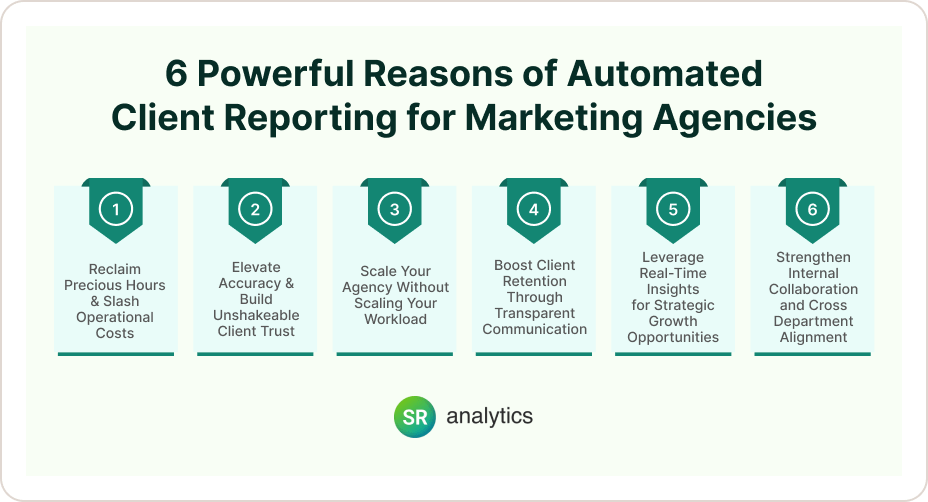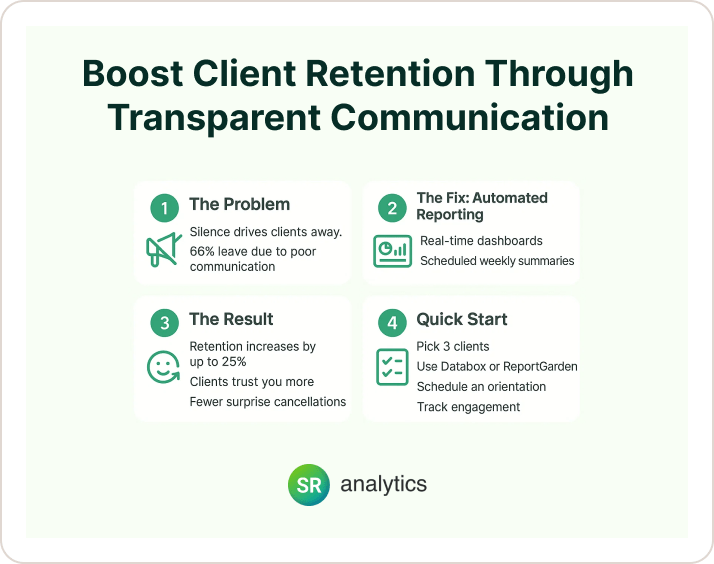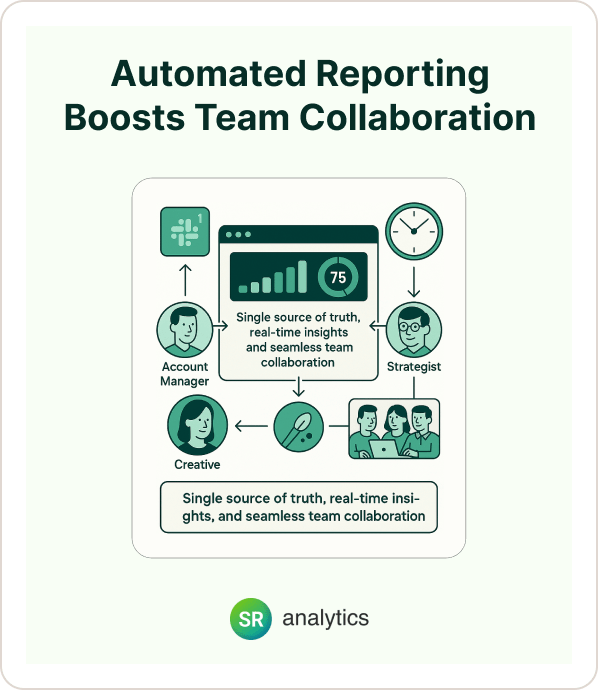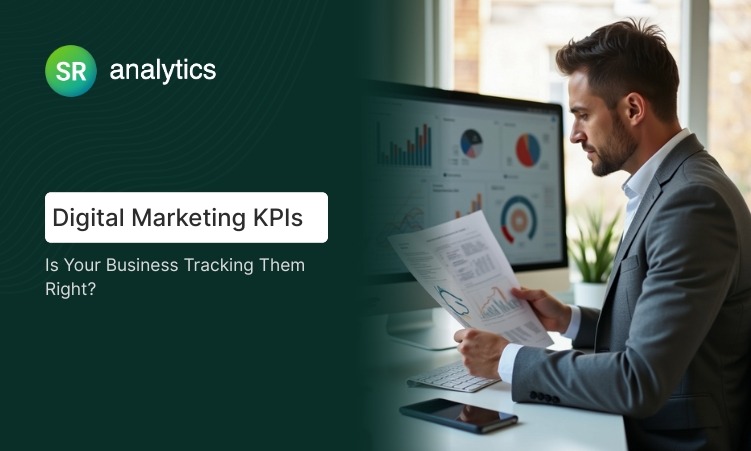Is your agency drowning in spreadsheets while client strategy takes a backseat? You’re throwing away an entire workweek each month on manual reporting tasks. Let that sink in.
I’ve watched countless brilliant marketers reduce themselves to data entry specialists, copying numbers from one platform to another. It’s not just inefficient—it’s killing your agency’s potential. Manual reporting is more than a tedious chore—it’s a profit killer.
The good news? Automated client reporting can reclaim those 50+ hours monthly and transform how your agency operates, grows, and retains clients. From boosting operational efficiency to driving smarter, real-time decisions, automating client reporting is no longer a competitive edge—it’s the new baseline.
Let me show you six undeniable reasons why automating your client reporting isn’t optional anymore—it’s essential.

1. Reclaim Precious Hours and Slash Operational Costs
The cost of manual reporting isn’t just time—it’s cold, hard cash flowing out of your business. Most agencies underestimate the operational drain of creating client reports by hand.
The shocking reality:
- Marketing teams waste 50+ hours monthly on report creation
- Agencies recover $100,000+ annually by implementing automated client reporting solutions
- Manual reporting creates a hidden tax on every client relationship
One agency owner recently told me: “Before we automated reporting, my team looked exhausted by Wednesday. Now I actually see them smiling on Fridays.”
Think about what your team could do with an extra week each month:
- Develop innovative client strategies
- Pursue new business opportunities
- Actually take vacation days without falling behind
- Optimize underperforming campaigns
- Upskill or learn new platforms
Try this today:
- Pick your most time-consuming client report
- Time how long it takes to create from start to finish
- Multiply that by your hourly rate
- Test platforms like AgencyAnalytics, Whatagraph, or DashThis with that one report
- Track time saved after automation
The ROI of automating client reporting becomes clear within weeks—not months.
The Compounding Impact of Time Savings
Time saved isn’t just a resource gain—it’s a compounding investment. If your agency saves 50 hours a month, that equates to 600 hours per year. What could your team achieve with 600 more hours?
- Build a scalable lead gen funnel
- Launch a client education series
- Deep-dive into analytics and refine your best-performing campaigns
- Systematize internal onboarding and SOPs
Time is the one resource you can’t replenish. When you automate client reporting, you’re buying back time at scale.
2. Elevate Accuracy and Build Unshakeable Client Trust
We’ve all experienced that stomach-dropping moment when a client spots an error in your report. Manual data handling isn’t just tedious—it’s dangerous for client relationships.
The trust-eroding truth:
- Error rates in manual reporting range from 18% to 40%
- Each mistake chips away at client confidence
- Trust takes months to build but seconds to destroy
A digital marketing director in Chicago shared: “After automating client reporting, our client conversations completely shifted. We stopped defending our numbers and started discussing strategy instead.”
Their client satisfaction jumped 32% in just one quarter.
How Automation Improves Accuracy
- Direct integrations with data sources mean fewer copy-paste mistakes
- Version control helps you track changes and catch anomalies
- Validation rules flag suspicious data before it hits the client
Implementation roadmap:
- Start with your most data-heavy clients
- Look for platforms with direct API connections to your marketing tools (Google Ads, Meta, HubSpot, etc.)
- Prioritize automated client reporting solutions that update in real-time
- Involve clients in the transition to build excitement
Bonus Tip: Create a version-controlled report archive. Automated reporting for clients often allows you to track revisions and show data lineage—further boosting client confidence.
The Long-Term Trust Dividend
Trust is the foundation of client retention. Agencies that provide consistent, error-free reporting become trusted advisors. When clients know the data is accurate, they’re more likely to:
- Approve budget increases
- Accept campaign pivots
- Refer your agency to others
3. Scale Your Agency Without Scaling Your Workload
Adding one new client somehow creates three clients’ worth of work—especially when it comes to reporting.
Growth breaks processes that worked perfectly at a smaller scale. The traditional 1:1 workload ratio between clients and reporting effort becomes unsustainable.
The scaling breakthrough:
- s creates non-linear growth potential
- Your reporting infrastructure scales instantly with zero additional effort
- New clients no longer mean proportional increases in admin work
A boutique agency I work with grew from 11 to 27 clients in under 8 months. Their owner explained: “Without automated reporting for clients, we would have needed two more people just for reports. Instead, we hired another strategist and a content specialist.”
Scaling Up Without Breaking Your Team
- Standardize templates for repeatable success
- Use dynamic report filtering by campaign, channel, or client
- Assign user access levels by team roles for easier collaboration
Practical scaling approach:
- Create standardized reporting templates by client type (e-commerce, SaaS, local business, etc.)
- Roll out automated client reporting solutions one client group at a time
- Document your new process for seamless onboarding
- Use the time saved to pursue higher-value clients or partnerships
Automating client reporting doesn’t just reduce workload—it multiplies your capacity to serve better clients without overextending your team. Our business intelligence consulting services help you standardize templates, build intelligent dashboards, and create processes that scale effortlessly.
4. Boost Client Retention Through Transparent Communication

You know what makes clients nervous? Silence. You know what makes them shop for other agencies? That same silence.
The transparency advantage:
- Clients rarely leave because of one bad month
- They leave because they don’t understand what’s happening
- Automated reporting for clients creates radical transparency
- 24/7 dashboard access eliminates uncertainty and builds trust
The retention impact is substantial:
- Agencies using automated reporting see retention improvements up to 25%
- Transparent reporting reduces client anxiety
- Regular data visibility creates natural conversation opportunities
Keeping Clients in the Loop—Automatically
Set automated weekly email summaries. Most tools allow you to schedule custom digests, including:
- Week-over-week performance comparisons
- KPIs by channel or conversion path
- Spend pacing and forecast modeling
Action plan for next Monday:
- Select three test clients (one at risk, one stable, one loyal)
- Set up 24/7 dashboards using tools like Databox or ReportGarden
- Schedule 30-minute orientation calls
- Track their engagement level and client sentiment over the next month
Bonus benefit: Transparent, real-time reporting makes monthly check-ins faster, more strategic, and more impactful —especially when powered by automated client reporting solutions.
5. Leverage Real-Time Insights for Strategic Growth Opportunities
Monthly reports are like navigating by looking only in your rearview mirror. Real-time insights flip the script.
When you automate client reporting, you transform backwards-looking documents into forward-looking intelligence hubs.
Real-time advantage examples:
- Spot performance spikes while you can still capitalize on them
- Identify and fix issues before clients even notice them
- Recognize cross-selling opportunities at the perfect moment
- Make data-backed recommendations that feel almost prescient
Real results:
- Agencies using automated systems report 30% productivity jumps
- Real-time insights enable faster strategic pivots
- Proactive recommendations dramatically increase client perception of value
Simple implementation:
- Set up automated alerts for significant performance changes
- Create notification thresholds for key metrics (±15% is a good start)
- Establish a rapid response protocol for both problems and opportunities
- Schedule weekly team reviews of automated insights
Staying Ahead of the Curve
Real-time data allows you to:
- Anticipate campaign fatigue before it hits
- Spot seasonal demand surges and act early
- Compare performance by time-of-day or location
Modern clients expect this level of responsiveness. Automating client reporting is how you meet—and exceed—those expectations.
6. Strengthen Internal Collaboration and Cross-Department Alignment

Automated client reporting doesn’t just benefit client communication—it fuels better collaboration inside your agency.
How it improves team performance:
- Shared dashboards create a single source of truth across account managers, strategists, and creatives
- Automation eliminates the need to “chase down numbers” during internal reviews
- Teams can focus on creative problem solving instead of data wrangling
Internal productivity boost:
- Time saved on reporting is reinvested in ideation, testing, and optimization
- Performance metrics are visible to everyone—not buried in spreadsheets
- Cross-functional teams work from the same real-time insights
Agency-wide integration tips:
- Use Slack or Microsoft Teams integrations to push key metrics daily
- Design internal KPIs dashboards for leadership visibility
- Create a culture of proactive data use, not just postmortem analysis
By automating client reporting, you foster a culture of data-first collaboration that makes your entire agency more agile and aligned.
The Bottom Line: Either Automate or Get Left Behind

Automated client reporting isn’t a luxury feature anymore. It’s as essential to running a modern agency as having a website. In a landscape where client expectations are rising and margins are shrinking, automating client reporting is one of the few changes that improves both service delivery and profitability.
The most successful agencies have already figured this out. They’ve:
- Liberated their teams from spreadsheet hell
- Redirected talent toward strategic thinking
- Focused on meaningful client relationships
- Created scalable systems that support growth
- Built deeper internal alignment around client goals
Your agency absolutely deserves—and now requires—this same advantage to stay competitive.
Tomorrow morning action plan:
- Grab your coffee
- Pull up your most detailed client report
- Highlight everything that could be automated (it’s probably 90%+)
- Make a simple plan to tackle that one report first
- Schedule time next week to evaluate the results
- Small steps lead to transformative changes.






